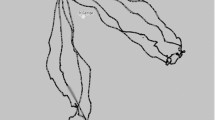Abstract
Models are described for the joint analysis of live-trapping and radio telemetry data from a study on black bears (Ursus americanus) in which all animals received ear tags and a subset also received radio tags. Concerns about bias in survival estimates led to investigation of identifiability and estimator precision for a series of models that allowed differenttelemetry relocation rates for living and dead animals, in addition to emigration and seasonal variation in survival. Identifiability was determined by showing that the expected information matrix was nonsingular. Models with fidelity constant across time, and with the same degree of time specificity for survival rates and relocation rates for dead animals, were determined to be nonidentifiable. More general models, with a greater degree of time specificity for survival rates, were near-singular, and estimators under these near-singular models had poor precision. Analysis of data from the study on black bears illustrated that estimates of survival have poor precision when relocation rates are estimated separately for live and dead animals. It is recommended that the effort expended to relocate both living and dead animals be consistently high in each telemetry survey, so that relocation rates will be high and constant across time and mortality status.
Similar content being viewed by others
References
Azzalini, A. (1996), Statistical Inference Based On The Likelihood, New York: Chapman & Hall.
Bennetts, R. E., Dreitz, V. J., Kitchens, W. M., Hines, J. E., and Nichols, J. D. (1999), “Annual Survival of Snail Kites in Florida: Comparisons Between Radio-Telemetry and Capture-Resighting Data,” Auk, 116, 435–447.
Catchpole, E. A., Freeman, S. N., and Morgan, B. J. T. (1996), “Steps to Parameter Redundancy in Age-Dependent Recovery Models,” Journal of Royal Statistical Society, 58, 763–774.
Catchpole, E. A., Kgosi, P. M., and Morgan, B. J. T. (2001), “On the Near-Singularity of Models For Animal Recovery Data,” Biometrics, 57, 720–726.
Catchpole, E. A., and Morgan, B. J. T. (1997), “Detecting Parameter Redundancy,” Biometrika, 84, 187–196.
— (2001), “Deficiency of Parameter-Redundant Models,” Biometrika, 88, 593–598.
Catchpole, E. A., Morgan, B. J. T., and Freeman, S. N. (1998), “Estimation in Parameter-Redundant Models,” Biometrika, 85, 462–468.
Hightower, J. E., Jackson, J. R., and Pollock, K. H. (2001), “Use of Telemetry Methods to Estimate Natural and Fishing Mortality of Striped Bass in Lake Gaston, North Carolina,” Transactions of the American Fisheries Society, 130, 557–567.
International Mathematical and Statistical Libraries, Inc. (1987), User’s Mannual STAT/Library FORTRAN Subroutines for Statistical Analysis, Houston, TX: Author.
Nasution, M. D. (2000), “Estimating Survival from Joint Analysis of Resighting and Radio-Telemetry Data in Wildlife Populations” unpublished doctoral dissertation, North Carolina State University at Raleigh, Dept. of Statistics
Nasution, M. D., Brownie, C., and Pollock, K. H. (2001), “Estimating Survival. From Joint Analysis of Resighting and Radio-telemetry Capture-recapture Data For Wild Animals,” Journal of Agricultural, Biological, and Environmental Statistics, 6, 461–478.
Pollock, K. H., Bunck, C. M., Winterstein, S. R. and Chen, C. L. (1995), “A Capture-Recapture Survival Analysis Model for Radio Tagged Animals,” Journal of Applied Statistics, 22, 661–672.
Searle, S. R. (1982), Matrix Algebra Useful For Statistics, New York: Wiley.
Sorensen, V. A., and Powell, R. A. (1998), “Estimating Survival Rates of Black Bears,” Canadian Journal of Zoology, 76, 1335–1343.
Tsai, K., Pollock, K. H., and Brownie, C. (1999), “Effects of Violation of Assumptions for Survival Analysis methods in Radiotelemetry Studies,” Journal of Wildlife Management, 63, 1369–1375.
Viallefont, A., Lebreton, J. D., Reboulet, A. M., and Gory, G. (1998), “Parameter Identifiability and Model Selection in Capture Recapture Models: A Numerical Approach,” Biometrical Journal, 40, 313–325.
White, G. C. (1983), “Numerical Estimation Of Survival Rates From Band-Recovery and Biotelemetry Data,” Journal of Wildlife Management, 47, 716–728.
Author information
Authors and Affiliations
Corresponding author
Rights and permissions
About this article
Cite this article
Nasution, M.D., Brownie, C., Pollock, K.H. et al. The effect on model identifiability of allowing different relocation rates for live and dead animals in the combined analysis of telemetry and recapture data. JABES 9, 27–41 (2004). https://doi.org/10.1198/1085711043181
Received:
Revised:
Issue Date:
DOI: https://doi.org/10.1198/1085711043181




